Jurassic Park 3-D Review: Marriage of Movie and 3-D Works
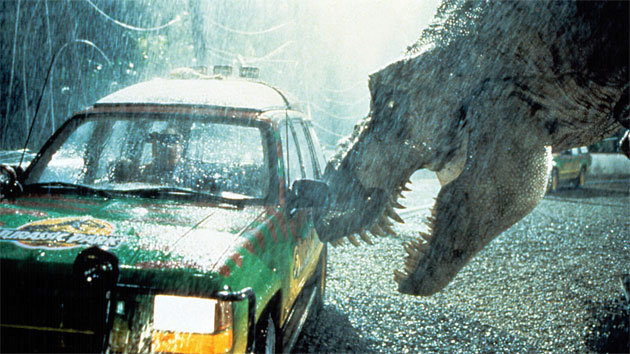
“What kind of park is this?” “It’s right up your alley,” says Dr. John Hammond (Richard Attenborough), answering a skeptical yet intrigued Dr. Alan Grant (Sam Neill) early on in the updated 3-D version of Stephen Spielberg’s 1993 dinosaurs-run-amok classic,
Jurassic Park. The film, originally shot at Universal Studios, and in Hawaii, has received the treatment of an extra dimension to act as a polish for its 20-year anniversary, making it one of many in the long line of 3-D converted re-releases.
But as the running time passes, the effect is taken notice, refreshing the senses and leaving a sense of nostalgia in the memories of moviegoers who watched the feature two decades ago. The 3-D, while not exactly eye candy in the most overwhelming sense, doesn’t distract from the storyline, which is still the same, fine one it was when scripted in ’93.
The premise, which even non-Spielberg fans ought to know, involves Paleontology Doctors Alan Grant and Ellie Sattler (Sam Neill and Laura Dern) and Mathematics Dr. Ian Malcolm (Jeff Goldblum) who are invited by Dr. Hammond to come to an island off Costa Rica to evaluate the safety of a theme park called “Jurassic Park” after a worker there was killed. From there, we are introduced to two of Dr. Hammond’s grandkids Tim and Lex Murphy (Joseph Mazzello and Ariana Richards), his employees Dennis Endry and Ray Arnold (Wayne Knight and Samuel L. Jackson), his investors’ lawyer Donald Gennaro (Martin Ferrero), and a park full of real dinosaurs. The dinosaurs, engineered by means of cloning from the blood of a preserved mosquito, come in all types, including tyrannosaurus rexes, triceratops, velociraptors, and more. Note, however, that all of them are female so none of them have the opportunity to breed, which would decentralize population control, says a geneticist.
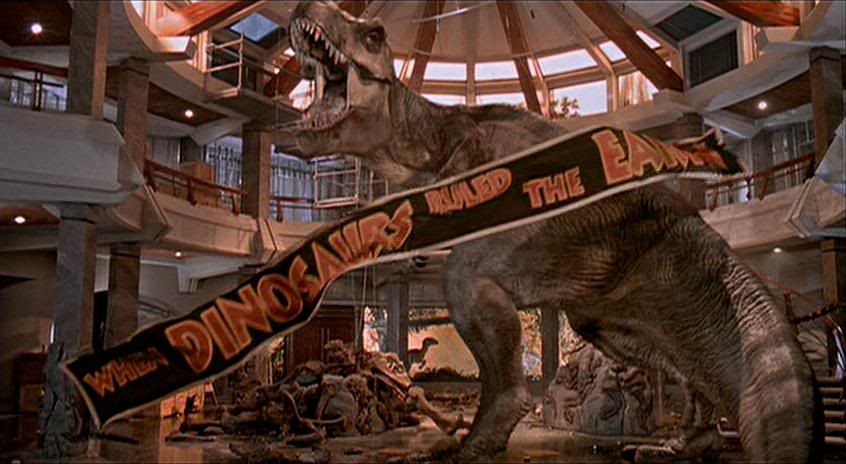
But it doesn’t matter as the excursion into 100 million years ago turns into a nightmarish miscalculation as the sky darkens, the rain falls, and a worker, who has been colluding with nefarious outside sources, scrambles the control room server and dashes out with dinosaur DNA in hand. To say he doesn’t make it out alive is an understatement.
The rest, predictable but exciting, is about trying to reconnect the electric grid and collecting everybody (alive) to get off the dreaded island.
During this second half, however, you begin to wonder how smart these people really are. Yes, he made tower-high dinosaurs out of microscopic rubble, but was following through on that to make these carnivorous creatures a tourist attraction Dr. Hammond’s brilliant idea? Or how about the lawyer who hides in a shanty bathroom as protection from a T-Rex?
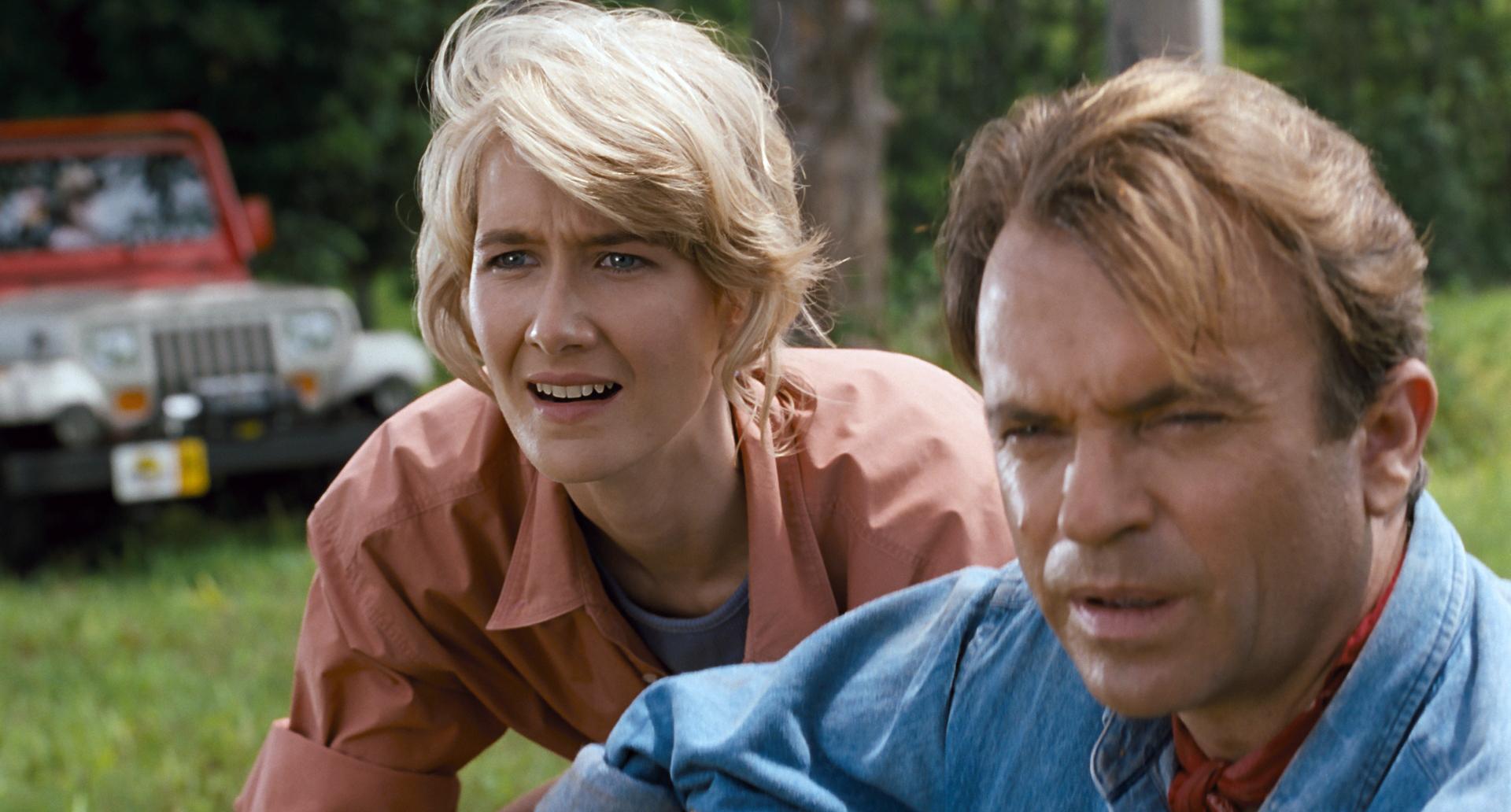
There are also the lapses in focus in the second half that stall some of the drama. For example, there is a subplot about an underdeveloped relationship between Doctors Grant and Sattler. And how some of the movie is dedicated to shaping and manipulating Dr. Grant’s negative attitude toward children to a more affectionate, loving one is even more cloying and arbitrary. Like when Dr. Grant is separated from the group and finds himself alone with the Dr. Hammond’s grandkids, acting as their father figure, comforting them and holding their hand through the treachery of it all. Eventually, he learns to love children. But to what extent do these side narratives accomplish? I didn’t know. And I didn’t care.
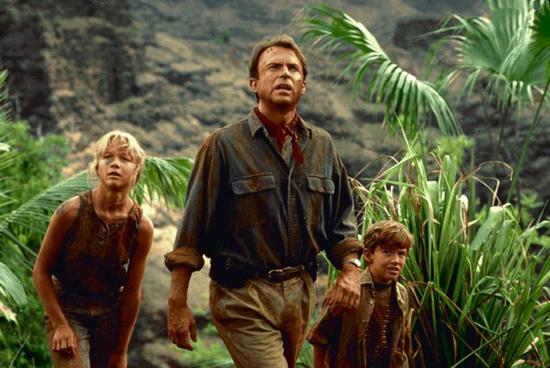
Despite these setbacks, the film continues to demonstrate that, after all these years, it can act doubly as a paralyzer of awe-inducing spectacle and manufactured thrill machine. The close calls are many, but visceral. The designs and senses of scale of the landscapes and dinosaurs are impeccable. The variety of shots and angles add to the intensity, such as a close up headshot revealing the fear a character experiences. And the 3-D manages to benefit the movie, not merely as just a distraction from some screenplay hazards, but visually, too. I must admit that I am not a big fan of 3-D. So consider me surprised when I discovered that my heart raced whenever dinosaurs ran toward me. One particularly spectacular scene involves a T-Rex chasing the Goldblum character who, flare in hand, is sprinting for the front row theater seats.
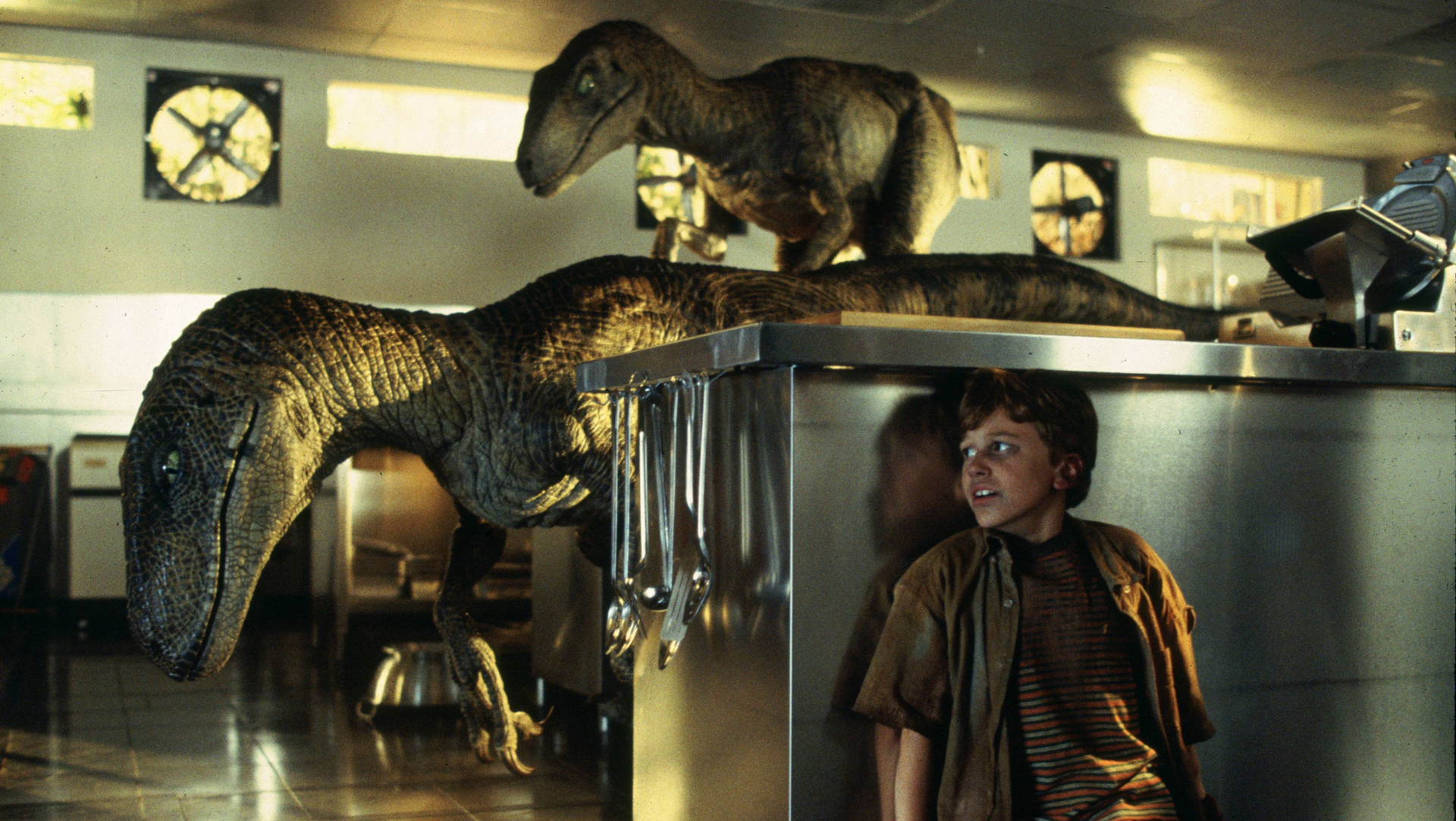
With the 3-D obscuring some shortcomings, typically overlooked scenes are now highlighted. In the nerve-racking moments when the two children are trapped by two velociraptors in a kitchen, the dinosaurs are shown to be intelligent creatures, shown by their personified tendencies to open doors and successively tap their claws on the linoleum floor like a girl would hers on a table in eager anticipation. The comparison is chilling itself, made more intriguing when you realize all the dinosaurs on the island are female. Here the theme of female dominion seems to be a profound element in Spielberg’s direction. This suggestion might otherwise be muted by said shortcomings
.
Jurassic Park 3-D is a film that simply builds off the original’s features with an optical enhancement. Much of the work was still done by the original’s creators, but this one magnifies the jolts and scares (which aren’t of the typical peek-a-boo variety), thanks in part to the big screen, ear-ringing audio, and, of course, 3-D. And though it doesn’t hold the timelessness of Spielberg’s other classics, like
Jaws,
Jurassic Park 3-D proves Hollywood special effects and directorial storytelling techniques can work effectively together. It’s a relatively small work from a big-time director, but like the massive foot imprints the characters see in the ground, the film leaves an indelible, deep impression on those who see it. In 1993,
Jurassic Park revolutionized special effects, and in 2013 it has re-revolutionized them
 “What kind of park is this?” “It’s right up your alley,” says Dr. John Hammond (Richard Attenborough), answering a skeptical yet intrigued Dr. Alan Grant (Sam Neill) early on in the updated 3-D version of Stephen Spielberg’s 1993 dinosaurs-run-amok classic, Jurassic Park. The film, originally shot at Universal Studios, and in Hawaii, has received the treatment of an extra dimension to act as a polish for its 20-year anniversary, making it one of many in the long line of 3-D converted re-releases.
But as the running time passes, the effect is taken notice, refreshing the senses and leaving a sense of nostalgia in the memories of moviegoers who watched the feature two decades ago. The 3-D, while not exactly eye candy in the most overwhelming sense, doesn’t distract from the storyline, which is still the same, fine one it was when scripted in ’93.
The premise, which even non-Spielberg fans ought to know, involves Paleontology Doctors Alan Grant and Ellie Sattler (Sam Neill and Laura Dern) and Mathematics Dr. Ian Malcolm (Jeff Goldblum) who are invited by Dr. Hammond to come to an island off Costa Rica to evaluate the safety of a theme park called “Jurassic Park” after a worker there was killed. From there, we are introduced to two of Dr. Hammond’s grandkids Tim and Lex Murphy (Joseph Mazzello and Ariana Richards), his employees Dennis Endry and Ray Arnold (Wayne Knight and Samuel L. Jackson), his investors’ lawyer Donald Gennaro (Martin Ferrero), and a park full of real dinosaurs. The dinosaurs, engineered by means of cloning from the blood of a preserved mosquito, come in all types, including tyrannosaurus rexes, triceratops, velociraptors, and more. Note, however, that all of them are female so none of them have the opportunity to breed, which would decentralize population control, says a geneticist.
“What kind of park is this?” “It’s right up your alley,” says Dr. John Hammond (Richard Attenborough), answering a skeptical yet intrigued Dr. Alan Grant (Sam Neill) early on in the updated 3-D version of Stephen Spielberg’s 1993 dinosaurs-run-amok classic, Jurassic Park. The film, originally shot at Universal Studios, and in Hawaii, has received the treatment of an extra dimension to act as a polish for its 20-year anniversary, making it one of many in the long line of 3-D converted re-releases.
But as the running time passes, the effect is taken notice, refreshing the senses and leaving a sense of nostalgia in the memories of moviegoers who watched the feature two decades ago. The 3-D, while not exactly eye candy in the most overwhelming sense, doesn’t distract from the storyline, which is still the same, fine one it was when scripted in ’93.
The premise, which even non-Spielberg fans ought to know, involves Paleontology Doctors Alan Grant and Ellie Sattler (Sam Neill and Laura Dern) and Mathematics Dr. Ian Malcolm (Jeff Goldblum) who are invited by Dr. Hammond to come to an island off Costa Rica to evaluate the safety of a theme park called “Jurassic Park” after a worker there was killed. From there, we are introduced to two of Dr. Hammond’s grandkids Tim and Lex Murphy (Joseph Mazzello and Ariana Richards), his employees Dennis Endry and Ray Arnold (Wayne Knight and Samuel L. Jackson), his investors’ lawyer Donald Gennaro (Martin Ferrero), and a park full of real dinosaurs. The dinosaurs, engineered by means of cloning from the blood of a preserved mosquito, come in all types, including tyrannosaurus rexes, triceratops, velociraptors, and more. Note, however, that all of them are female so none of them have the opportunity to breed, which would decentralize population control, says a geneticist.
 But it doesn’t matter as the excursion into 100 million years ago turns into a nightmarish miscalculation as the sky darkens, the rain falls, and a worker, who has been colluding with nefarious outside sources, scrambles the control room server and dashes out with dinosaur DNA in hand. To say he doesn’t make it out alive is an understatement.
The rest, predictable but exciting, is about trying to reconnect the electric grid and collecting everybody (alive) to get off the dreaded island.
During this second half, however, you begin to wonder how smart these people really are. Yes, he made tower-high dinosaurs out of microscopic rubble, but was following through on that to make these carnivorous creatures a tourist attraction Dr. Hammond’s brilliant idea? Or how about the lawyer who hides in a shanty bathroom as protection from a T-Rex?
But it doesn’t matter as the excursion into 100 million years ago turns into a nightmarish miscalculation as the sky darkens, the rain falls, and a worker, who has been colluding with nefarious outside sources, scrambles the control room server and dashes out with dinosaur DNA in hand. To say he doesn’t make it out alive is an understatement.
The rest, predictable but exciting, is about trying to reconnect the electric grid and collecting everybody (alive) to get off the dreaded island.
During this second half, however, you begin to wonder how smart these people really are. Yes, he made tower-high dinosaurs out of microscopic rubble, but was following through on that to make these carnivorous creatures a tourist attraction Dr. Hammond’s brilliant idea? Or how about the lawyer who hides in a shanty bathroom as protection from a T-Rex?
 There are also the lapses in focus in the second half that stall some of the drama. For example, there is a subplot about an underdeveloped relationship between Doctors Grant and Sattler. And how some of the movie is dedicated to shaping and manipulating Dr. Grant’s negative attitude toward children to a more affectionate, loving one is even more cloying and arbitrary. Like when Dr. Grant is separated from the group and finds himself alone with the Dr. Hammond’s grandkids, acting as their father figure, comforting them and holding their hand through the treachery of it all. Eventually, he learns to love children. But to what extent do these side narratives accomplish? I didn’t know. And I didn’t care.
There are also the lapses in focus in the second half that stall some of the drama. For example, there is a subplot about an underdeveloped relationship between Doctors Grant and Sattler. And how some of the movie is dedicated to shaping and manipulating Dr. Grant’s negative attitude toward children to a more affectionate, loving one is even more cloying and arbitrary. Like when Dr. Grant is separated from the group and finds himself alone with the Dr. Hammond’s grandkids, acting as their father figure, comforting them and holding their hand through the treachery of it all. Eventually, he learns to love children. But to what extent do these side narratives accomplish? I didn’t know. And I didn’t care.
 Despite these setbacks, the film continues to demonstrate that, after all these years, it can act doubly as a paralyzer of awe-inducing spectacle and manufactured thrill machine. The close calls are many, but visceral. The designs and senses of scale of the landscapes and dinosaurs are impeccable. The variety of shots and angles add to the intensity, such as a close up headshot revealing the fear a character experiences. And the 3-D manages to benefit the movie, not merely as just a distraction from some screenplay hazards, but visually, too. I must admit that I am not a big fan of 3-D. So consider me surprised when I discovered that my heart raced whenever dinosaurs ran toward me. One particularly spectacular scene involves a T-Rex chasing the Goldblum character who, flare in hand, is sprinting for the front row theater seats.
Despite these setbacks, the film continues to demonstrate that, after all these years, it can act doubly as a paralyzer of awe-inducing spectacle and manufactured thrill machine. The close calls are many, but visceral. The designs and senses of scale of the landscapes and dinosaurs are impeccable. The variety of shots and angles add to the intensity, such as a close up headshot revealing the fear a character experiences. And the 3-D manages to benefit the movie, not merely as just a distraction from some screenplay hazards, but visually, too. I must admit that I am not a big fan of 3-D. So consider me surprised when I discovered that my heart raced whenever dinosaurs ran toward me. One particularly spectacular scene involves a T-Rex chasing the Goldblum character who, flare in hand, is sprinting for the front row theater seats.
 With the 3-D obscuring some shortcomings, typically overlooked scenes are now highlighted. In the nerve-racking moments when the two children are trapped by two velociraptors in a kitchen, the dinosaurs are shown to be intelligent creatures, shown by their personified tendencies to open doors and successively tap their claws on the linoleum floor like a girl would hers on a table in eager anticipation. The comparison is chilling itself, made more intriguing when you realize all the dinosaurs on the island are female. Here the theme of female dominion seems to be a profound element in Spielberg’s direction. This suggestion might otherwise be muted by said shortcomings.
Jurassic Park 3-D is a film that simply builds off the original’s features with an optical enhancement. Much of the work was still done by the original’s creators, but this one magnifies the jolts and scares (which aren’t of the typical peek-a-boo variety), thanks in part to the big screen, ear-ringing audio, and, of course, 3-D. And though it doesn’t hold the timelessness of Spielberg’s other classics, like Jaws, Jurassic Park 3-D proves Hollywood special effects and directorial storytelling techniques can work effectively together. It’s a relatively small work from a big-time director, but like the massive foot imprints the characters see in the ground, the film leaves an indelible, deep impression on those who see it. In 1993, Jurassic Park revolutionized special effects, and in 2013 it has re-revolutionized them
With the 3-D obscuring some shortcomings, typically overlooked scenes are now highlighted. In the nerve-racking moments when the two children are trapped by two velociraptors in a kitchen, the dinosaurs are shown to be intelligent creatures, shown by their personified tendencies to open doors and successively tap their claws on the linoleum floor like a girl would hers on a table in eager anticipation. The comparison is chilling itself, made more intriguing when you realize all the dinosaurs on the island are female. Here the theme of female dominion seems to be a profound element in Spielberg’s direction. This suggestion might otherwise be muted by said shortcomings.
Jurassic Park 3-D is a film that simply builds off the original’s features with an optical enhancement. Much of the work was still done by the original’s creators, but this one magnifies the jolts and scares (which aren’t of the typical peek-a-boo variety), thanks in part to the big screen, ear-ringing audio, and, of course, 3-D. And though it doesn’t hold the timelessness of Spielberg’s other classics, like Jaws, Jurassic Park 3-D proves Hollywood special effects and directorial storytelling techniques can work effectively together. It’s a relatively small work from a big-time director, but like the massive foot imprints the characters see in the ground, the film leaves an indelible, deep impression on those who see it. In 1993, Jurassic Park revolutionized special effects, and in 2013 it has re-revolutionized them